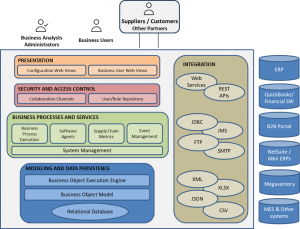Managing Business Complexity, Change and Variability through Adaptive Supply Chain Collaboration
Introduction – Adaptive Business Network Collaboration
Globalization, exponential advances in technology, shortened product lifecycles and social commerce are changing the competitive landscape. Unknown companies are emerging overnight and dominating industries using information and time as competitive weapons. A company’s success in the “new normal” economy is increasingly less dependent on individual performance and more dependent on the overall success of the supply chains in which they participate.
For too long, companies have focused on traditional performance improvement areas, those
“within the four walls,” with continually diminishing returns. The real winners will transform their extended supply chain into a business network of synchronized partners focused on a common objective of satisfying customers better than their competing value chains. They will achieve new levels customer intimacy though their ability to sense change and deliver what the market is demanding before their competition has time to react.
The ability to rapidly sense changing market conditions and respond to sudden changes in demand is a necessity for doing business in todayʼs volatile global markets. To adapt to these constantly changing business requirements, todayʼs companyʼs need a new breed of supply chain software that is flexible and easily modified, without requiring extensive custom software changes.
Vecco provides sophisticated collaboration execution solutions that transform traditional, sequential supply chains into highly responsive and adaptive business networks. Veccoʼs Allegro suite of business network solutions is built and deployed using Veccoʼs Collaborative Application Framework (CAF). This whitepaper provides an overview of the Allegro CAF and how it enables Adaptive Supply Chain Collaboration.
Collaborative Application Framework Overview
Given the constantly changing requirements of todayʼs global business a new breed of cost-effective, highly configurable and real-time collaboration solutions is needed. A web-based architecture with an intelligent ground-up design based on the latest and most advanced technologies and approaches is required to create a supply chain collaboration platform that can dynamically adapt to changing business strategies and live market conditions.
Veccoʼs Collaborative Application Framework (CAF) is designed from the ground up to support the dynamic information and decision-making requirements of today’s complex, multi-tier supply chains. CAF is a cloud-based business solutions platform comprised of a loosely coupled set of frameworks, deployed across multiple servers and accessible to users and systems via the Internet. CAF’s service-oriented, business model driven architecture allows for the development of tailored applications through configuration rather than custom code.
The requirement of CAF to enable adaptive supply chain collaboration across multiple partners, distributed globally, drove several import design concepts. CAF supports synchronous and asynchronous message-based communications for many-to-many interactions across heterogeneous systems and multiple time zones, languages and currencies. It features fault-tolerance and high-availability performance and load balancing. CAF supports secure communication channels and external user repositories for user authentication (LDAP), and enforces role-based access controls to safeguard against unauthorized access. CAF was built on open systems and industry standards to ensure maximum compatibility with your existing and future IT investments.
CAF requires no software or hardware investment from business partners. The business-ready integration framework provides a lightweight enterprise service bus to quickly integrate with your existing infrastructure as well as those of your trading partners. The benefit of the Allegro Collaborative Application Framework is that it takes less time to build and deploy new business processes, and adapt them to your entire trading network. CAF is designed to quickly solve complex problems at lower cost, while being able to rapidly sense, respond and capitalize on the constant changes in companiesʼ business environments.
In the following pages, this whitepaper elaborates on the concepts introduced above, and their role in enabling collaborative, highly adaptive business networks.
Federated Enterprise Architecture
To create an adaptive business network, you need to implement multi-party business processes and share common business objectives with your suppliers and customers, while at the same time maintaining the flexibility to pursue independent processes. Veccoʼs CAF follows a federated collaborative approach where you and your partners can each maintain your own workflows, business procedures, and data security. A collaborative event handler flexibly determines which data is needed, and when it is needed, so that your company can efficiently and securely exchange information with others. This differs from an “extended enterprise” approach that forces all participants to share a common instance of the data repository, and ignores differences in business rules and procedures across the different companies. CAF enables end-to-end business process orchestration across a multi-tier supply chain.
CAF Federated Enterprise Architecture Diagram

Distributed Extensible plug-and-play Components
Business relationships and processes continually evolve over time as market conditions change. It is important that the system be able to handle the incremental change without disruption to operations. The CAF architecture is composed of numerous software components. Each is an independent software entity, which can be added into your system without changing the components you have already installed. CAF components are designed to communicate as loosely coupled services, enabling built-in and plug-in orchestration of many disparate computing services. This provides for accommodating a wide variety of supply chain models and partner capabilities into a common definition of the business process semantics. Also, CAF components can be distributed across different hosts via a LAN or WAN by simply changing the configuration – no additional software is required. The result is flexible deployment to meet your evolving business requirements.
Standards-Driven
Complete use of industry standards is a requirement for global collaboration systems that must handle the divergent needs of numerous business, planning and supply chain systems. The use of open standards allows you to leverage a larger pool of third-party products and services, reduce training and on-going maintenance costs and lower your total cost of ownership.
CAF was designed to support international, industry, and de facto standards, ensuring that applications built using CAF are open and extensible; maximizing your ability to leverage existing software investments. CAF-supported standards include: Java/J2EE, JMS, JAAS, JDBC, JCA/JCE, JNDI, JMX, RMI, SOAP, WSDL, UDDI, HTTP/HTTPS, JMS, JDBC, SMTP/POP (with S/MIME), FTP, XML, XSLT, XPath, XQuery, JavaScript and others.
Open System Approach
A global business network must leverage data and information from many distributed sources running on different platforms. To do this flexibly and efficiently requires an open system approach. CAF provides open interfaces to all of its services at many levels, ranging from SQL queries to a relational database, EJB and Java packages, to web services using SOAP. Furthermore, its flexible XML-based query language provides ad hoc query and maintenance capability to all business objects in CAF. CAF supports multiple platforms running on Microsoft Windows, as well as Linux and UNIX.
Interoperability – Leveraging Existing Investments
CAF’s business-ready integration framework supports the leading open, interoperability standards through its configuration templates. This provides a highly configurable, plug-and-play environment for real-time information sharing for any participant, anywhere in the end-to-end supply chain.
Thus, CAF is designed to work with third-party or back-end systems to leverage your existing investments. It provides open interfaces for multiple back-end systems to work together, shielding collaborative applications from being specifically tied to the APIs of multiple back-end systems. CAF’s Service Framework can also be used to wrap legacy system functionality into Web Services.
Synchronous and Asynchronous Messaging
Business partners and users will be distributed globally across different time zones and will have different working rules and hours of operation. In this type of environment, it is necessary to support real-time communication as well as delayed communication when you and your partners are not available at the same time. CAF supports both synchronous and asynchronous communication methods. CAF features an event notification service based on the publish/subscribe paradigm, enabling highly efficient and guaranteed communication among you and your business partners. This decouples senders from receivers so you can dynamically add new participants and flexibly accommodate a large number of components, external applications and users.
High Availability, Scalability, and Security
CAF was conceived and developed for mission-critical business network collaboration applications with 24/7, 99.99% uptime requirements. CAFʼs robust and scalable environment, with built-in load sharing and auto restart mechanism, helps ensure your business collaboration platform will always be available. The flexible services architecture allows seamless, automated and unlimited scaling across different platforms and environments.
Security is critical in multi-tier collaborative business processes as multiple enterprises are involved and sensitive data is exchanged. Allegro supports LDAP-based user authentication and role-based authorization, which can be controlled at multiple levels: business object interfaces, topics, and message context. The CAF architecture only requires HTTP(S) messages to pass through the firewall; no other ports are required for access.


